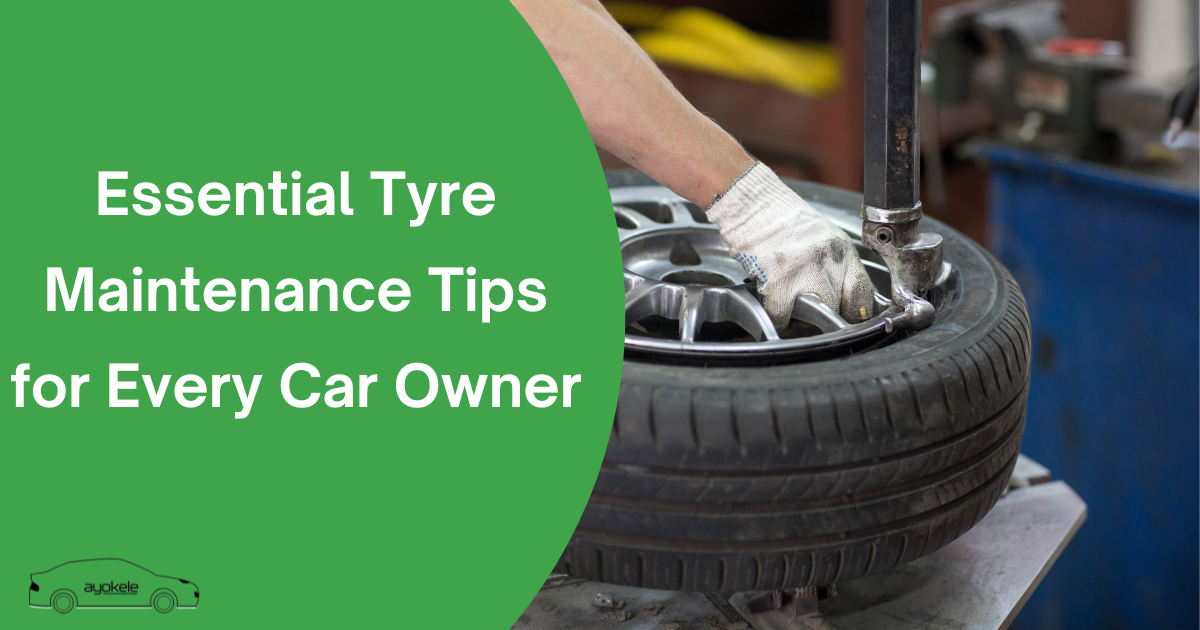Tyres represent the only contact points between your vehicle and the road, making them critical components for safety, performance, and fuel efficiency. Despite their importance, tyre maintenance remains one of the most overlooked aspects of vehicle care. Proper tyre maintenance not only extends their lifespan—saving you money—but significantly improves handling, braking distance, and overall safety. This guide covers essential tyre maintenance practices every car owner should implement.
Understanding Tyre Pressure
Maintaining correct tyre pressure is the single most important aspect of tyre maintenance. Underinflated tyres flex excessively, generating heat that accelerates wear and increases the risk of blowouts. They also create greater rolling resistance, reducing fuel efficiency by up to 3% for every 10% they’re underinflated. Conversely, overinflated tyres have reduced contact with the road, compromising traction and handling while wearing unevenly across the center of the tread.
The recommended pressure for your vehicle isn’t a suggestion—it’s a carefully calculated specification. This information is typically found on a sticker inside the driver’s door jamb, in the owner’s manual, or inside the fuel door. Note that the maximum pressure printed on the tyre sidewall is not the recommended inflation level but rather the maximum safe pressure the tyre can contain.
Check your tyre pressure at least monthly and before long journeys. For the most accurate readings, measure when tyres are cold (before driving or at least three hours after). Seasonal temperature changes significantly affect pressure—typically decreasing in colder weather and increasing in hotter conditions—requiring regular adjustments throughout the year.
Tread Depth Monitoring
Tyre tread provides crucial channels for water displacement, preventing hydroplaning on wet surfaces. As tread wears down, your vehicle’s ability to maintain traction in wet conditions diminishes dramatically. In Nigeria’s tropical climate with frequent heavy rainfall, adequate tread depth becomes even more critical for safety.
The legal minimum tread depth in most jurisdictions is 1.6mm, though safety experts recommend replacement at 3mm, especially for driving in wet conditions. To check your tread depth without specialized tools, insert a 1 Naira coin into the tread groove. If you can see the top of the engraving on the coin, your tyres have worn below 3mm and should be considered for replacement.
Monitor tread wear patterns as they reveal valuable information about your vehicle’s condition. Even wear across the tyre surface indicates proper inflation and alignment. Center wear suggests overinflation, while wear along both edges indicates underinflation. Wear concentrated on one edge often signals alignment problems, while patchy or scalloped wear patterns may indicate suspension issues or imbalanced tyres.
Regular Rotation and Balancing
Front and rear tyres wear differently due to their distinct roles in steering, driving, and braking. Regular rotation equalizes wear patterns, extending overall tyre life by up to 20%. For most vehicles, rotation every 8,000-10,000 kilometers provides optimal benefits, though check your owner’s manual for manufacturer-specific recommendations.
The appropriate rotation pattern depends on your vehicle’s drivetrain. For front-wheel drive vehicles (most common in Nigeria), the front tyres typically move to the rear while the rear tyres move to the opposite sides at the front. Rear-wheel and four-wheel drive vehicles follow different patterns specified in your owner’s manual.
Tyre balancing ensures weight is distributed evenly around each tyre, preventing vibration and uneven wear. Have your tyres balanced when they’re rotated and whenever you notice steering wheel vibration at certain speeds. This service typically costs between ₦2,000-4,000 per wheel but saves substantially more by preventing premature tyre replacement and protecting suspension components from vibration damage.
Wheel Alignment
Proper wheel alignment ensures all tyres contact the road at the correct angle, distributing wear evenly while optimizing handling and fuel efficiency. Misalignment often occurs after hitting potholes or curbs—unfortunately common on many Nigerian roads. Signs of misalignment include the vehicle pulling to one side, uneven or rapid tyre wear, and a steering wheel that’s off-center when driving straight.
Professional alignment service typically costs between ₦15,000-25,000 but represents an excellent investment by preventing premature tyre wear that could otherwise cost five times that amount in early replacements. Most vehicles benefit from alignment checks annually or whenever you notice the warning signs mentioned above.
Different types of misalignment affect vehicles differently. Toe misalignment (where tyres point inward or outward) causes the most rapid wear, while camber issues (where tyres tilt inward or outward at the top) affect handling and even wear. Caster problems (affecting the steering axis angle) influence directional stability and steering effort.
Visual Inspection Routine
Develop the habit of visually inspecting your tyres regularly—ideally weekly, but at minimum during your monthly pressure check. Look for:
- Cuts, cracks, or bulges in the sidewall indicating potential structural damage
- Foreign objects like nails or screws embedded in the tread
- Uneven wear patterns suggesting alignment or inflation issues
- Signs of aging such as multiple small cracks in the rubber (common in Nigeria’s hot climate)
- Damage to wheel rims that might cause air leaks or compromise structural integrity
Pay particular attention to sidewall damage, as this area lacks the reinforcement found in the tread area. Even minor-looking sidewall damage can lead to dangerous blowouts, especially at highway speeds. Any bulges or bubbles in the sidewall indicate internal damage requiring immediate tyre replacement regardless of remaining tread depth.
Age Matters
Even with adequate tread remaining, tyres degrade over time due to environmental factors. Rubber compounds deteriorate through exposure to heat, ultraviolet radiation, and oxygen—all abundant in Nigeria’s climate. Most manufacturers recommend replacing tyres after six years regardless of appearance or remaining tread depth.
To determine your tyre’s age, locate the DOT (Department of Transportation) code on the sidewall. The last four digits indicate the manufacturing date—the first two numbers represent the week, and the last two represent the year. For example, “2318” indicates the tyre was manufactured in the 23rd week of 2018.
Proper storage extends tyre life. If storing seasonal tyres or a vehicle for extended periods, keep tyres in a cool, dry location away from direct sunlight, electrical motors (which produce ozone that degrades rubber), and petroleum products. Vehicles stored long-term should ideally be on jack stands to prevent flat-spotting and sidewall stress.
Valve Stems and Caps
These small components play a crucial role in maintaining pressure. Rubber valve stems deteriorate over time and may develop slow leaks. Have them inspected during tyre rotations and replaced during new tyre installation. Always keep valve caps in place—they prevent dust and moisture from entering the valve and causing corrosion that leads to air leaks.
Metal valve stems, though more expensive initially, offer greater durability and reliability, particularly for vehicles regularly driven at highway speeds where higher pressures and centrifugal forces place additional stress on these components.
Spare Tyre Maintenance
Your spare tyre requires the same maintenance as those in active use. Check its pressure monthly alongside your other tyres, as a flat spare defeats its emergency purpose. For vehicles with full-size spares, include this tyre in your regular rotation schedule to ensure even wear across all five tyres.
Temporary “donut” spares have specific pressure requirements—typically higher than standard tyres—and severe speed and distance limitations. Familiarize yourself with these restrictions before needing to use your temporary spare in an emergency situation.
Professional Inspection Value
While regular self-maintenance is essential, professional inspection provides additional value. Trained technicians can identify developing issues before they become visible to the untrained eye. Schedule professional tyre inspections during routine oil changes or other maintenance visits.
Professional inspection becomes particularly important before long journeys or after significant impacts with potholes or road debris. The modest cost of inspection provides valuable peace of mind and potentially prevents dangerous failures in challenging situations.
Develop a consistent maintenance schedule and keep records of rotations, balancing, and replacements. The small time investment in regular tyre care pays substantial dividends through improved safety, enhanced performance, better fuel economy, and reduced overall operating costs. Your tyres literally carry the weight of your vehicle and its occupants—giving them the attention they deserve is both financially prudent and potentially life-saving.




